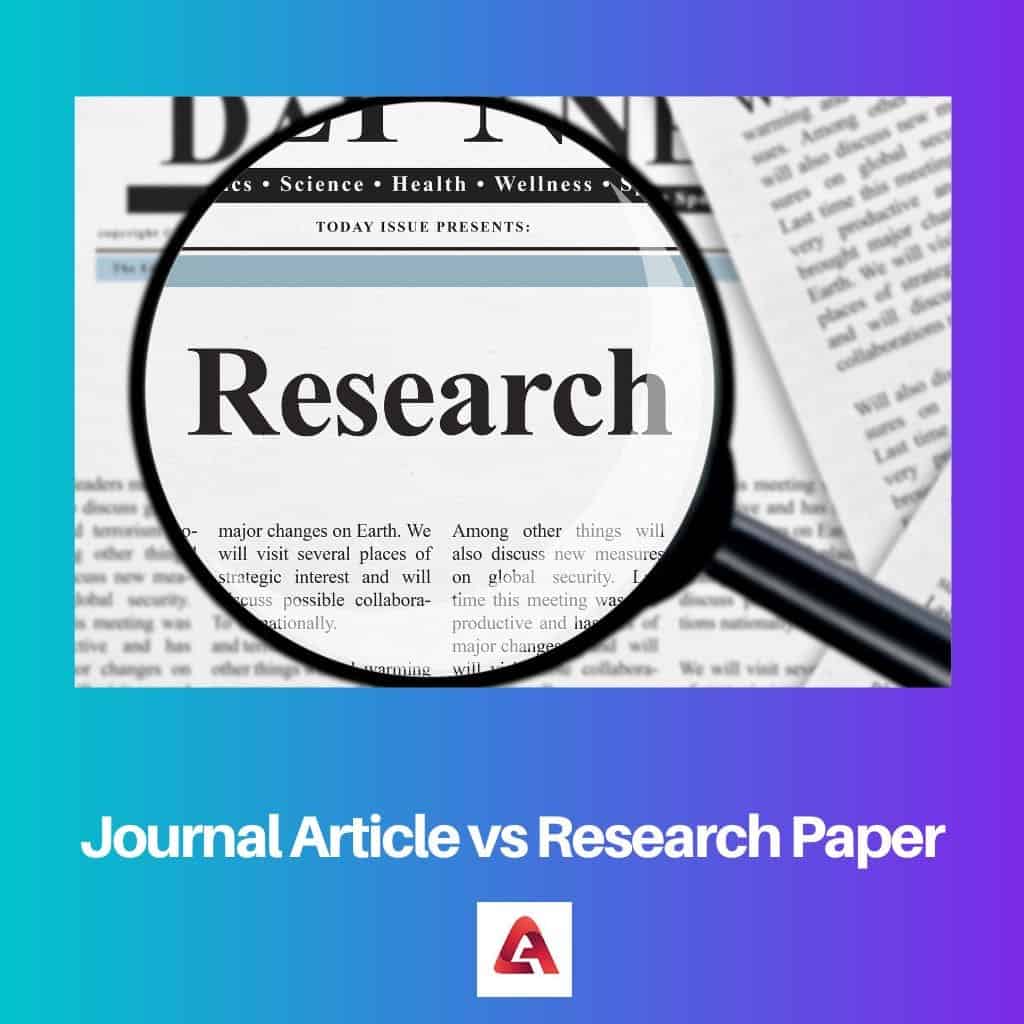A journal article presents original research findings in a concise format, focusing on a specific topic within a broader field. It undergoes peer review before publication, ensuring quality and validity. On the other hand, a research paper is a comprehensive document that may include multiple experiments, analyses, and discussions, aimed at contributing to the advancement of scientific knowledge.
Key Takeaways
- A journal article is a shorter scholarly writing published in a specific academic journal.
- A research paper is a more extended, comprehensive academic writing presenting original research.
- Journal articles are more focused and present specific findings, while research papers are broader and present a more comprehensive study.
Journal Article vs Research Paper
A journal article is a piece of published work that presents the research findings and may include analysis, remark, or discussion. A research paper is a detailed account of the research that may be published or unpublished and includes an introduction, literature review, methods, results, and conclusion.

Comparison Table
| Feature | Journal Article | Research Paper |
|---|---|---|
| Definition | A scholarly publication presenting original research findings, published in a peer-reviewed academic journal. | A broader term encompassing various forms of written work presenting research findings, analysis, or arguments. |
| Audience | Primarily targeted towards researchers and scholars in a specific field. | Can have varying audiences depending on the purpose and context, including researchers, students, professionals, or the general public. |
| Length | Typically shorter, ranging from 5,000 to 10,000 words. | Can vary greatly in length, from a few pages for conference papers to book-length for dissertations. |
| Content | Focused on presenting original research conducted by the author(s), including methodology, results, discussion, and conclusions. | Can present original research, analyze existing research, offer critical evaluations, or propose new ideas and arguments. |
| Peer Review | Always undergoes a rigorous peer-review process before publication in a reputable journal. | May or may not undergo peer review, depending on the context and purpose of the paper. |
| Publication | Published in a peer-reviewed academic journal following specific format and style guidelines. | Can be published in various formats and venues, including academic journals, conference proceedings, books, or online platforms. |
What is Journal Article?
A journal article is a scholarly publication that presents the findings of original research, analysis, or review within a particular academic field. These articles serve as fundamental units of scholarly communication, disseminating new knowledge, theories, and insights to the academic community and beyond. Here’s a detailed breakdown:
Content and Structure
1 Abstract: A journal article begins with an abstract, a concise summary of the study’s objectives, methods, results, and conclusions. The abstract provides readers with a quick overview of the article’s content and findings.
2 Introduction: Following the abstract, the introduction sets the context for the study by reviewing relevant literature, identifying gaps or controversies in existing knowledge, and stating the research objectives or hypotheses.
3 Methods: The methods section outlines the procedures, materials, and techniques used to conduct the study. It should provide sufficient detail to enable replication of the experiment or analysis by other researchers.
4 Results: This section presents the findings of the study, using tables, figures, or graphs to illustrate data. Authors describe the results objectively, without interpretation or speculation.
5 Discussion: In the discussion section, authors interpret the results in light of the study’s objectives and existing literature. They may address the implications of their findings, suggest future research directions, and discuss limitations or potential sources of bias.
6 Conclusion: The conclusion summarizes the main findings of the study and highlights their significance. It may also reiterate the study’s contribution to the field and offer final reflections or recommendations.
Peer Review Process:
1 Submission: Authors submit their articles to scholarly journals for publication consideration, adhering to the journal’s guidelines and formatting requirements.
2 Peer Review: Upon submission, the journal’s editor assigns the manuscript to peer reviewers—experts in the field—who evaluate the article’s quality, originality, methodology, and significance. Peer review helps ensure the rigor and credibility of the research.
3 Revision: Based on the reviewers’ feedback, authors may revise their article to address any concerns or criticisms raised. This iterative process of revision and reevaluation continues until the article meets the journal’s standards for publication.
4 Acceptance and Publication: If the article meets the journal’s criteria, it is accepted for publication and undergoes final editing and formatting. Once published, the article becomes part of the journal’s archive and is accessible to readers worldwide.

What is Research Paper?
A research paper is a comprehensive document that presents the findings, analysis, and interpretations of original research conducted by the author(s) within a specific academic discipline. These papers serve as a means for scholars to contribute new knowledge, theories, and insights to their respective fields. Here’s a detailed breakdown:
1. Content and Structure
1 Introduction: The introduction of a research paper provides background information on the topic, reviews relevant literature, and outlines the research objectives or hypotheses. It establishes the context for the study and justifies its significance.
2 Methods: The methods section describes the procedures, materials, and techniques employed in the research. It should provide sufficient detail to enable other researchers to replicate the study and verify its results.
3 Results: This section presents the empirical findings of the research, using tables, figures, or graphs to illustrate data. Authors report their observations or measurements objectively, without interpretation or speculation.
4 Discussion: In the discussion section, authors interpret the results in light of the research questions or hypotheses, comparing them to previous studies and addressing their implications. They may also explore alternative explanations, limitations of the study, and avenues for future research.
5 Conclusion: The conclusion summarizes the main findings of the research and highlights their significance. It may reiterate the study’s contribution to the field, offer final reflections, and suggest directions for further inquiry.
Characteristics and Scope
1 Original Research: Unlike review papers or essays, research papers are based on original research conducted by the authors. They contribute new data, insights, or interpretations to the academic discourse.
2 Rigorous Methodology: Research papers adhere to rigorous scientific or scholarly methodologies, employing systematic approaches to data collection, analysis, and interpretation. They prioritize objectivity, validity, and reliability in their findings.
3 Length and Complexity: Research papers vary in length and complexity, depending on the scope of the study and the requirements of the target publication venue. They may range from concise reports of preliminary findings to comprehensive analyses of multi-year research projects.
4 Contribution to Knowledge: Research papers aim to advance knowledge within their respective fields by addressing research gaps, testing hypotheses, or generating new theories. They contribute to the cumulative growth of scholarship through the dissemination of original research findings.

Main Differences Between Journal Article and Research Paper
- Scope and Depth:
- Journal articles focus on a specific aspect or finding within a broader topic.
- Research papers provide a comprehensive analysis of a research project, including multiple experiments, analyses, and discussions.
- Length and Detail:
- Journal articles are concise, containing essential findings, methods, and interpretations in a limited space.
- Research papers tend to be longer and more detailed, offering exhaustive exploration of the research topic, methodology, results, and implications.
- Review Process:
- Journal articles undergo peer review by experts in the field before publication, ensuring quality and validity.
- Research papers may or may not undergo formal peer review, depending on the publication venue or academic requirements.
- Objective and Interpretation:
- Journal articles present findings objectively, without extensive interpretation or speculation.
- Research papers include in-depth interpretation of results, discussion of implications, and exploration of potential limitations or biases.
- Contribution to Knowledge:
- Journal articles contribute to the scholarly conversation by presenting new findings, analyses, or reviews within a specific topic area.
- Research papers advance knowledge within a field by offering comprehensive analyses, testing hypotheses, or generating new theories through original research.

- https://gssrr.org/index.php/gssrr/How-to-Publish-Research-Paper
- https://www.springer.com/gp/authors-editors/journal-author/types-of-journal-manuscripts/1356
- https://owl.purdue.edu/owl/general_writing/common_writing_assignments/research_papers/index.html

The characteristics of a journal article outlined in the article shed light on the structured nature of these scholarly publications. It’s important to understand the components that make up a journal article to effectively communicate research findings.
Agreed, knowing the key components of a journal article is essential for researchers aiming to publish their work in reputable academic journals.
Absolutely, the detailed breakdown of the characteristics of a journal article provides valuable insights for aspiring authors.
This article provides a clear and concise comparison between journal articles and research papers. It’s informative and well-structured. I appreciate the detailed explanation of the characteristics of each type of publication.
I agree, the article provides a comprehensive overview of the differences between journal articles and research papers. It’s a valuable resource for researchers and academics.
The characteristics of a journal article and a research paper are clearly delineated in the article, providing an insightful comparison between the two types of scholarly publications.
Absolutely, the article offers a comprehensive comparison that highlights the unique features of journal articles and research papers.
The article effectively differentiates between journal articles and research papers, offering a comprehensive understanding of the distinct characteristics and purposes of each type of scholarly publication.
I concur, the article serves as an illuminating guide for researchers and scholars navigating the intricacies of academic writing and publication.
The article offers a thorough understanding of the significance of journal articles and research papers in the academic and professional spheres. It serves as a valuable resource for individuals engaged in scholarly writing and research.
I find the comparison table provided in the article particularly helpful. It offers a quick reference for distinguishing between journal articles and research papers based on publication outlet, content, target audience, peer review, length, structure, emphasis, and impact.
Yes, the comparison table is a useful tool for researchers to understand the key differences between journal articles and research papers at a glance.
The comparison table and detailed explanations in the article provide a nuanced understanding of the unique features of journal articles and research papers, making it a valuable resource for the academic community.
Absolutely, the article offers a comprehensive analysis that elucidates the differences and similarities between journal articles and research papers.
The distinction between journal articles and research papers is crucial for academic writing. This article does a great job of highlighting those differences and their respective characteristics.
Absolutely, understanding the nuances between these two types of publications is essential for academic and scholarly work. This article does an excellent job of breaking it down.
The structure of a research paper outlined in the article serves as a helpful guide for researchers looking to compose comprehensive and well-organized scholarly documents. It offers a clear framework for presenting original research findings.
I found the breakdown of the structure of a research paper to be particularly enlightening. It offers a roadmap for researchers to follow when crafting their academic work.
Yes, understanding the structure of a research paper is essential for effectively communicating the results of a study. This article provides a detailed overview of what to include in a research paper.
The detailed explanation of the structure and content of a journal article and a research paper is beneficial for researchers seeking to refine their academic writing skills and publish their work.
Indeed, the article provides valuable insights into the components and organization of journal articles and research papers, aiding researchers in producing high-quality scholarly publications.